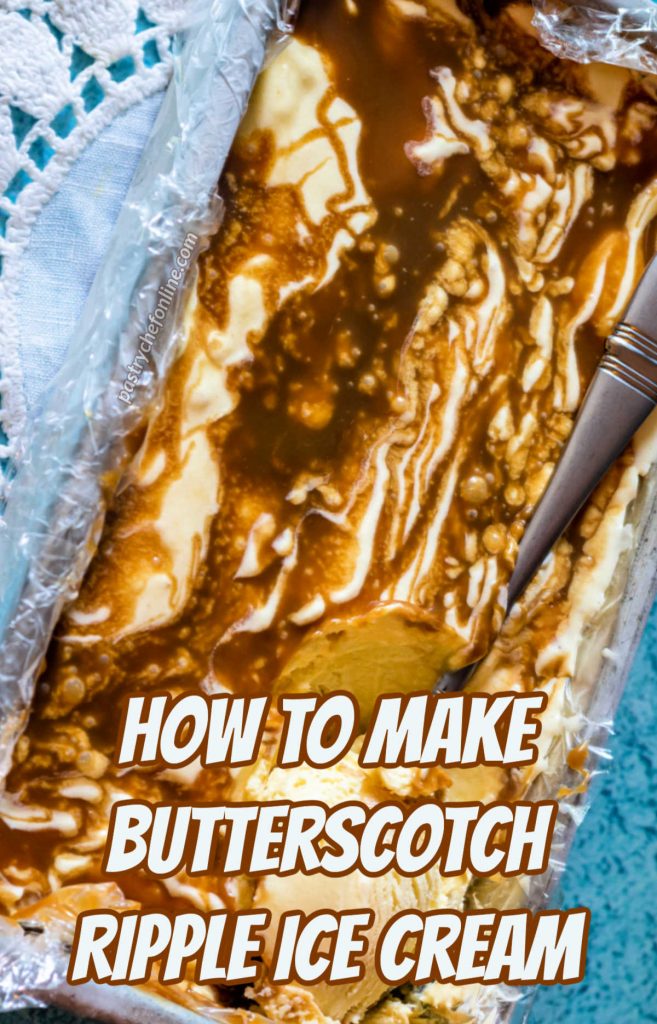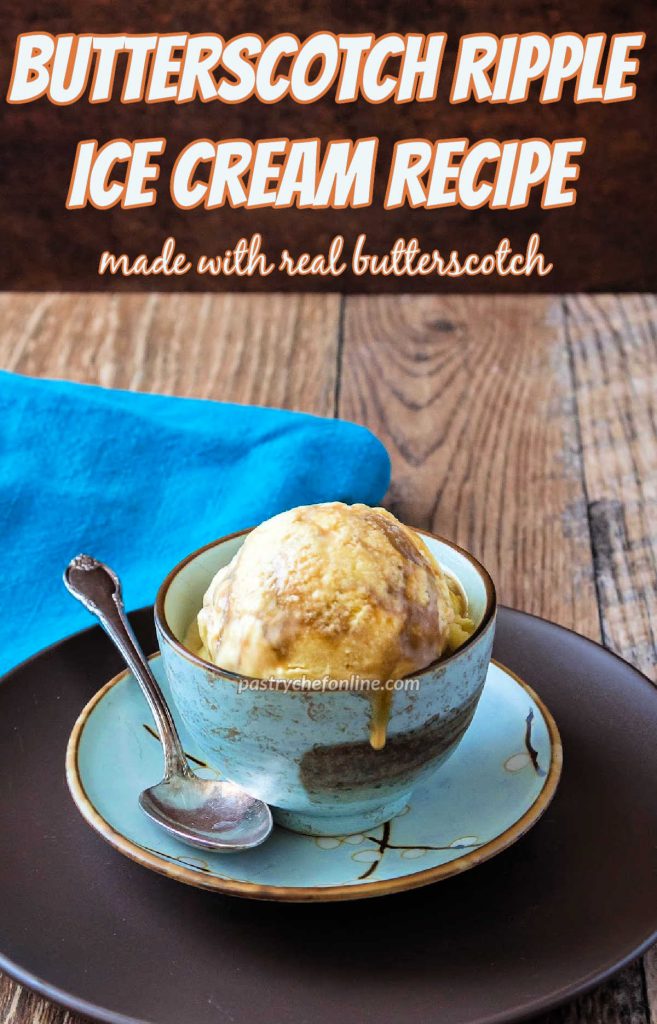Today, I’m bringing you an answer to a reader’s request: butterscotch ripple ice cream! A rich butterscotch sauce swirled with a lower-fat version of my French vanilla base. Because you have to make room for the sauce!
My reader was interested in a copycat recipe for Isaly’s Maricopa Ice Cream. I’d never heard of it before (it’s a Pittsburgh brand), but if you have a hankering for a butterscotch swirl ice cream, I think you’ll be very happy with it.
You may also enjoy my straight-up butterscotch ice cream or my recipe for butterscotch coffee syrup. Because it’s my favorite flavor, I have lots of versions on the site. For ease of browsing, you can find all my butterscotch recipes in one place. Thanks so much for visiting!
Pastry Chef Online Participates in Affiliate Programs. If you make a purchase through one of my links, I may earn a small commission. For more information click to read my disclosure policy
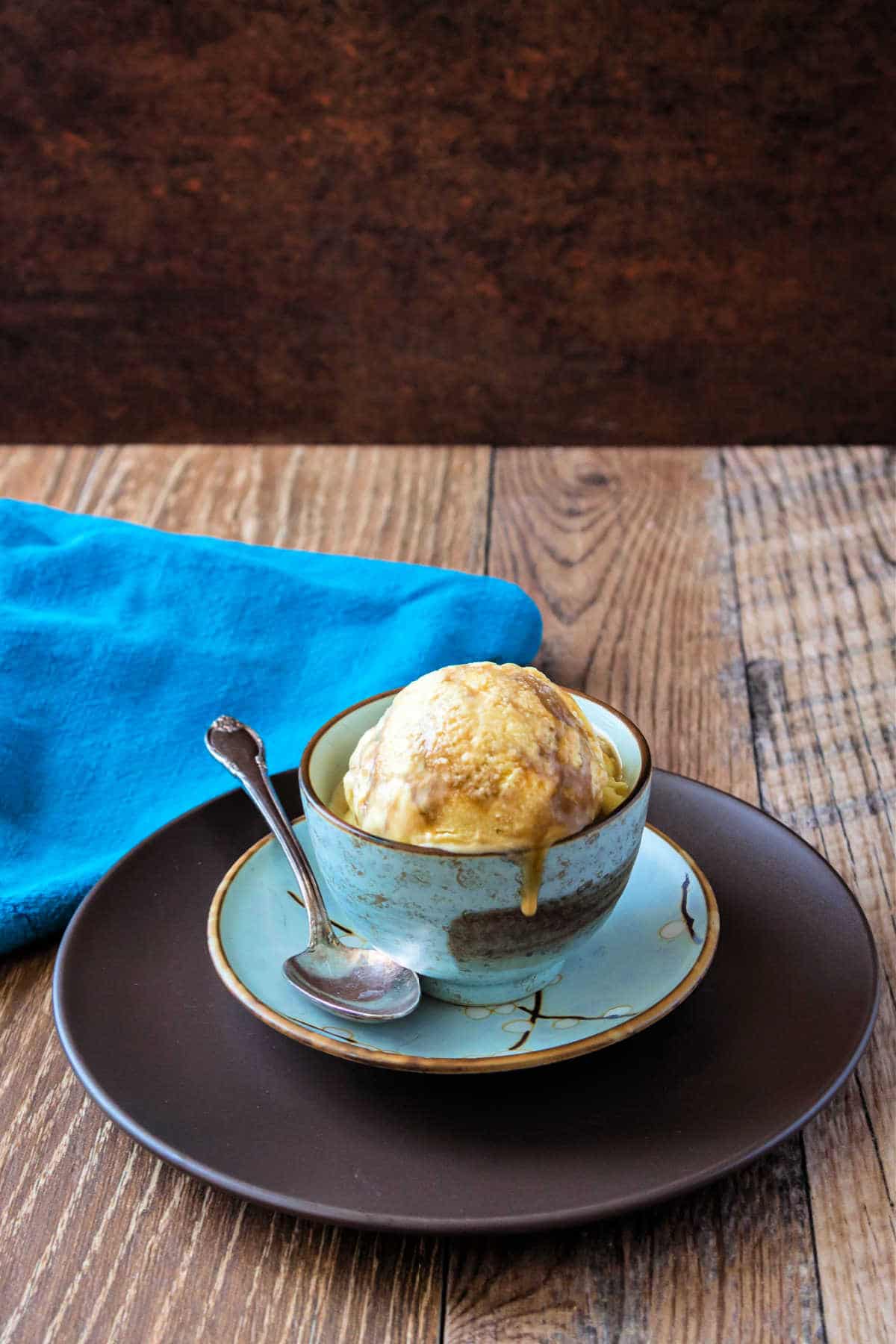
Butterscotch Ripple Ice Cream, At a Glance
✅Skill Level: Intermediate
✅Skills: Making Butterscotch, Making a Pate a Bombe
✅Type: Shaped Cookies
✅Number of Ingredients: For the Swirl: 6, for the Ice Cream: 8
✅Prep Time: 45 minutes
✅Cook Time: 15 minutes
✅Freezer Time: 8 hours
✅Yield: 8 servings
Jump Straight to the Recipe
The Quest for Butterscotch Ripple
Whenever I get a request for a copycat recipe, I always try to find the original ingredient list. That gives me a starting point for experimentation.
The Isaly’s folks do not have the recipes printed on their website, nor would they tell me the ingredients when I asked via email and social media.
Then I sent friends of friends who live in Pittsburgh on a mission to take a photo of the ingredient list for me. No dice. They tried, but Maricopa wasn’t stocked where they went.
My main question was this: Is the base French vanilla (custard-based with egg) or a Philadelphia style (no-egg) base?
It all came down to looking at photos (the vanilla appears to be a very pale yellow like a custard) and also the hunch that a Pittsburgh brand wouldn’t make a Philadelphia-style base.
French vanilla ice cream it was. And then off to the races.
Ratio of Ice Cream to Ripple
The thing you’ll most like about this recipe (I think, anyway), is that there is not too much butterscotch ripple. While that may sound like a bad thing, it’s actually a plus.
Butterscotch is a very assertive flavor, so to still be able to taste the vanilla notes in the base, the ripple takes a bit of a back seat to the ice cream.
It makes sense. You generally use much less sauce than the ice cream itself.
Less is definitely more. Of course, if you want a ton of swirl, you may double the swirl recipe.
Also, I worked hard to create a vanilla base as creamy as my original no-churn French vanilla ice cream while cutting back some on the fat and the sugar.
Again, you need to make room in the recipe for the sugar and fat present in the ripple, so the fat and sugar have to get cut somewhere. Otherwise, you end up with a dessert that is overly sweet, overly rich, and probably won’t freeze properly.
This butterscotch ripple ice cream freezes nice and firm so you have time to savor it before it melts.
If this ice cream sounds great to you and you decide to make it, I have a favor to ask:
When you do make this recipe, it will help me and other readers if you:
✅Rate the recipes using the stars in the recipe card
✅Leave a review when prompted in the recipe card (If it’s a positive review, and I hope it is, I’ll use it in the post as social proof)
✅Leave a comment on the post
Thank you so much!
How to Make This Recipe
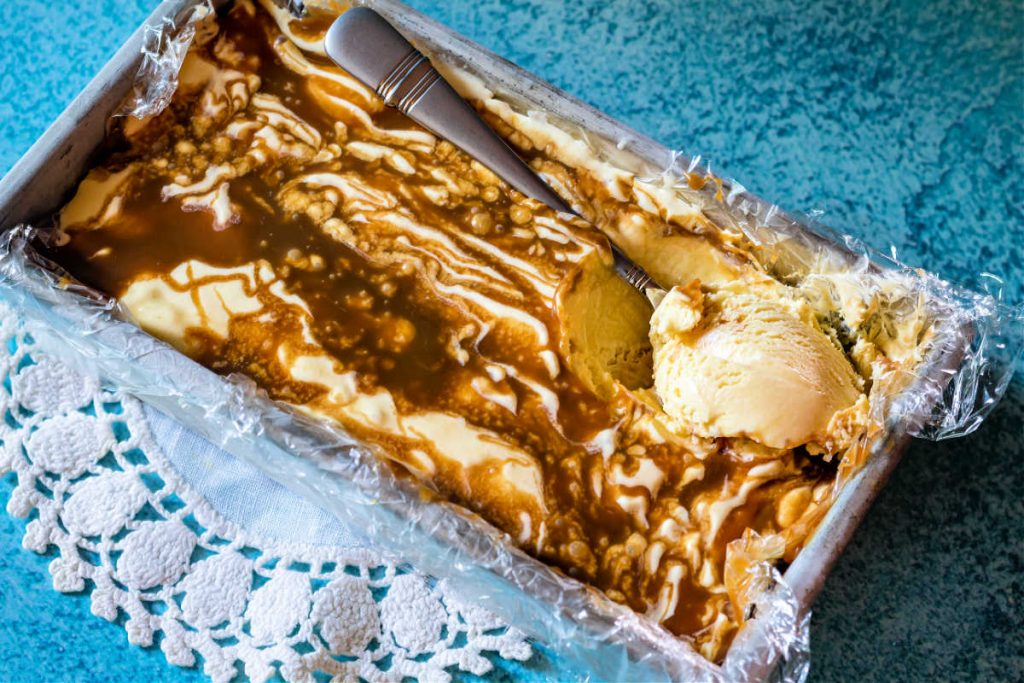
To make a butterscotch swirl ice cream, you need two different components: the base and the swirl itself.
PRO TIP
To make swirled ice cream, alternate layers of ice cream base and swirl. Then when you scoop it, you’ll get swirls in every scoop.
Ingredients and Substitutions
First up, the ripple. As a bonus, it can double as a butterscotch ice cream sauce.
If you’re ready to get started, you may skip to the recipe.
For the Butterscotch Ripple
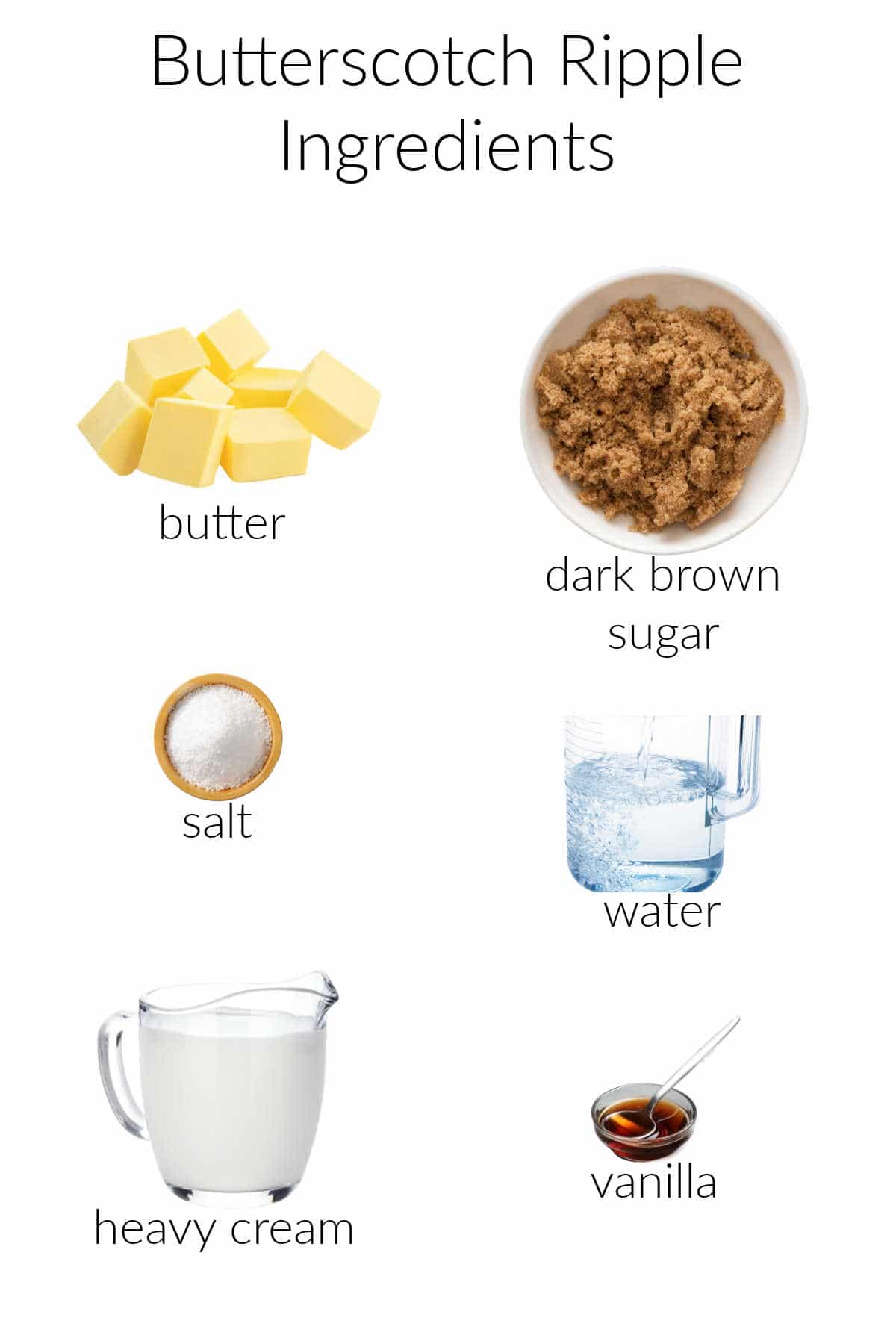
I contend that if you don’t see these three ingredients in a butterscotch recipe, it doesn’t qualify as true butterscotch. (If you are interested, you can read about the difference between butterscotch and caramel)
- unsalted butter: Adds the nutty, browned-butter flavor to butterscotch
- dark brown sugar: Adds the caramelized sugar and molasses flavors to butterscotch.
- salt: Brings out the other flavors as well as being an integral part of the flavor profile.
Subs: You may use light brown sugar if you don’t have dark brown. If all you have is granulated sugar, add 2 teaspoons of molasses to the sugar.
To those 3 ingredients, we add
- water: I have just started to add some water to my butterscotch mixture. The additional water (aside from the little bit of water present in the butter) ensures that the sugar dissolves completely so you end up with a perfectly smooth butterscotch that doesn’t recrystallize or get grainy in the fridge.
- heavy cream: Allows the butterscotch to pour–mellows the flavor just a bit
- vanilla extract: Rounds out the flavors. Not strictly necessary, but I do like to use it in mine
You may use half and half in place of the heavy cream. Don’t substitute whole milk, though, because the milk may curdle at such high temperatures.
Procedure for Making the Ripple
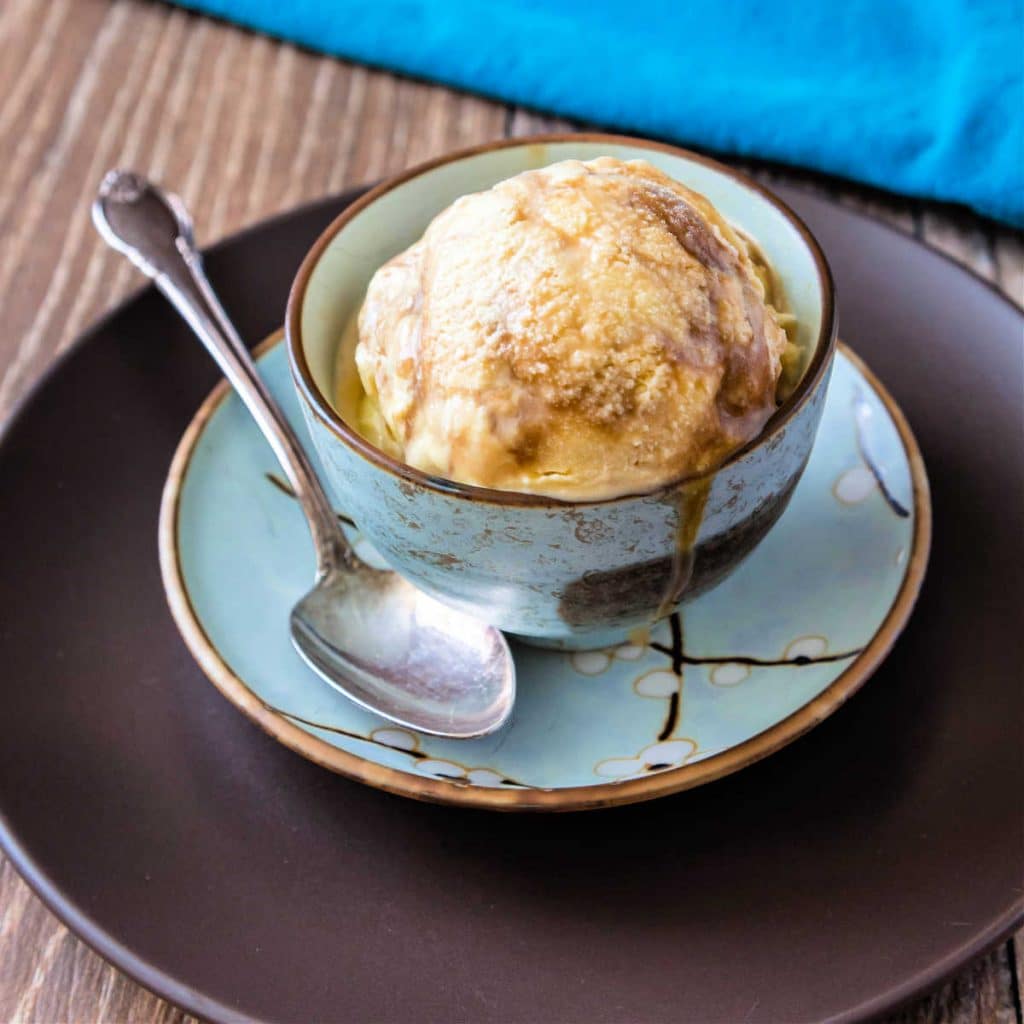
- Melt butter, brown sugar, and salt into the water.
- Bring to a boil and cook until the butter browns and the sugar caramelizes. Follow your nose! (See Tips and Tricks)
- Stir the cream.
- Cook until the mixture until it reaches the soft ball stage.
- Remove from heat, pour into another heat-proof container to stop the cooking, and stir in the vanilla.
- Cool to room temperature before layering it in with your base.
For the Ice Cream Base
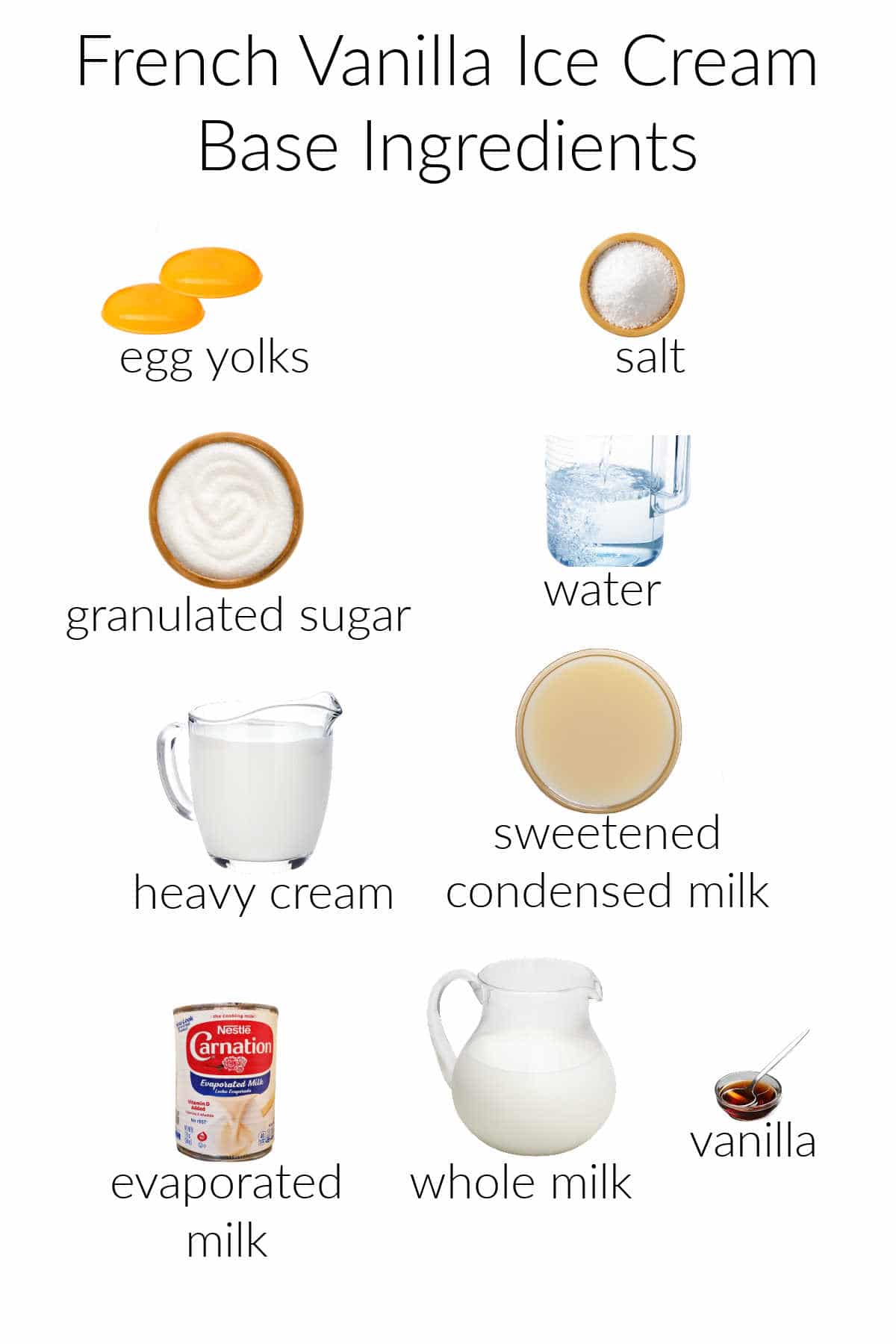
In my experimentation, I found that using evaporated milk adds to the volume of the base without adding too much additional water.
Would you like to save this post?
This results in a nice, creamy base that also happens to be lower in fat than my original French vanilla, which uses heavy cream and half and half.
- egg yolks: the yolks provide the custard base, and since they come in the form of a pate a bombe, they’re completely cooked, so there’s no need to cook the entire base.
- sugar: cooked into syrup, this provides sweetness as well as the heat necessary to cook the yolks. The finished pate a bombe also provides a nice, creamy mouthfeel since it’s full of wee, tiny bubbles
- water: to dissolve the sugar for the pate a bombe
- salt: whisked together with the yolks. I use less salt in this vanilla base than in most because the butterscotch ripple has plenty of salt in it
- heavy cream: whipped together with the sweetened condensed milk, these two ingredients are the base of most no-churn ice cream recipes
- sweetened condensed milk: You may use regular sweetened condensed milk or fat free
- evaporated milk: In my “regular” no-churn recipes, I use a full 16 oz of heavy cream. In this recipe, since it contains egg yolks and sugar cooked together in a pate a bombe, I wanted slightly less fat, so I use 10 oz of cream. The remainder of the original 6 oz are made up of 3 oz each evaporated milk and whole milk.
- whole milk: You could use all whole milk instead of using some evaporated milk, but I think that might make the ice cream too icy, since you’d be adding additional water. Most of the water is cooked out of evaporated milk, and that allows for a very creamy final product.
- vanilla: Provides the vanilla in French vanilla. You may use either vanilla extract or vanilla paste.
Procedure for Making the Ice Cream Base
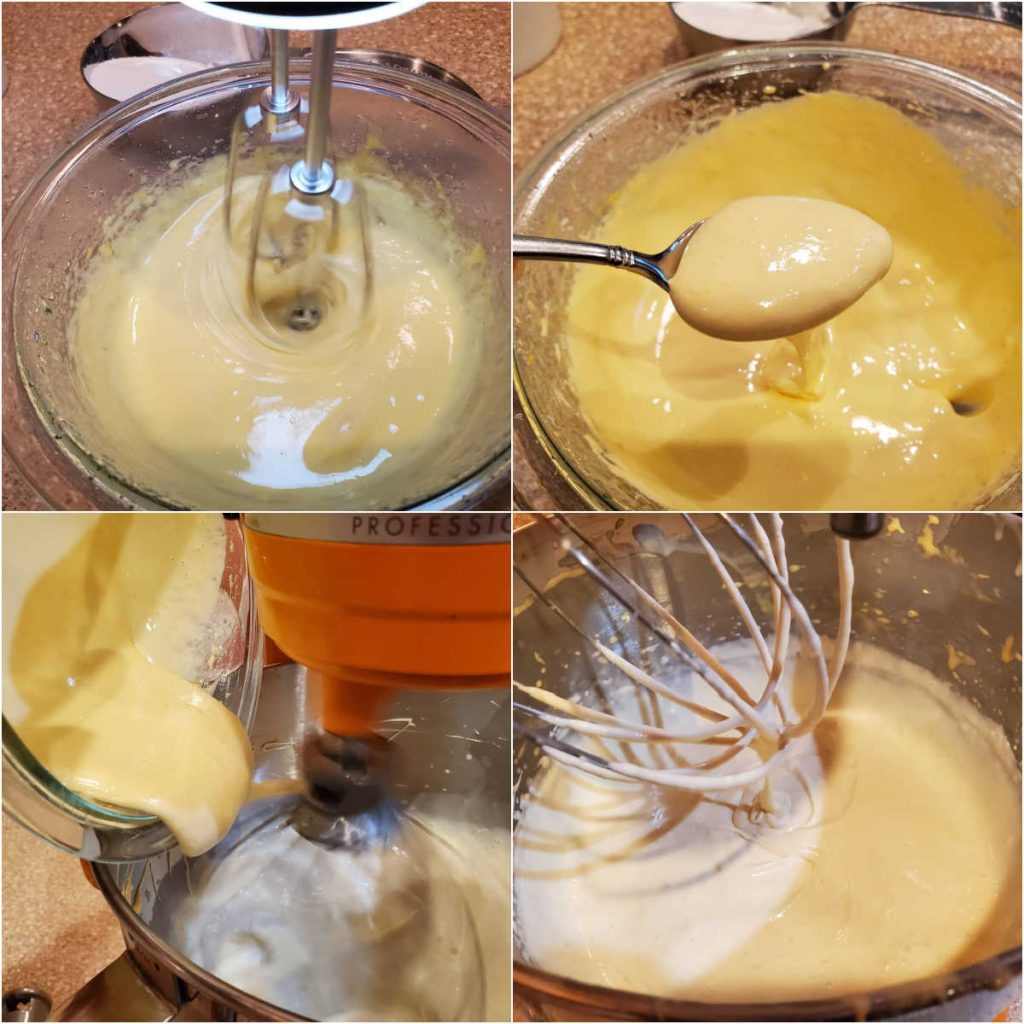
- Make the pate a bombe.
- Whip yolks and pinch of salt until creamy.
- Cook sugar and water together until it reaches 240F.
- Whip the hot syrup with the yolks until very light, billowy, and room temperature.
- Whip heavy cream, sweetened condensed milk, and vanilla until thickened but not at peaks. Whip will leave tracks in the cream.
- Whip in the pate a bombe.
- Add the evaporated milk and whole milk and stir until well-combined.
Equipment You May Need
To take the temperature of your sugar syrup for the ice cream base and the temperature of your butterscotch, you’ll need a good instant-read thermometer. Fortunately, they are not very expensive and are very accurate.
If you don’t have a
As far as ice cream containers are concerned, you can buy dedicated ones that are insulated like these, but I have good luck using cake pans or bread pans and some Saran wrap.
Tips and Tricks for Success
This is not a hard recipe to make, but it does require some patience with the layering.
Since this is such a rich ice cream, you really have to let each layer freeze for at least 45 minutes before adding the next.
Tip for Speeding Up the Process
If you don’t have the time to do all of that waiting, put the base in a metal bowl (if it isn’t already) and freeze it.
Whisk it very well every 30-45 minutes until it is very thick and about the consistency of soft-serve ice cream.
Then, you can quickly layer the base with the butterscotch before freezing the whole container.
Tip for Using a Churn
Even though this is technically a no-churn recipe, there is no reason you can’t speed up the process by churning your base before layering everything together.
Tip for Knowing When Your Butterscotch Is Done
Since sugar caramelizes at about 320F, you could take its temperature to know when your butterscotch is done.
I prefer to use my nose.
As the butterscotch cooks, it will smell pretty much like nothing to begin with.
Then it will smell like nutty brown butter, and eventually, it will start to smell like caramelized sugar.
As you stir your butterscotch overheat, keep smelling it. Once it starts to smell like caramelized sugar, you’ll know it’s ready. That’s when you’ll add the cream.
Butterscotch Ripple Ice Cream Q & A
Yes you can. Chill the base thoroughly and then churn according to the manufacturer’s instructions. Once it is very thick, go ahead and layer it together with the sauce.
Not necessarily. You can layer them individually when you serve it. Make the base and freeze. Keep the butterscotch in the fridge. When you want some ice cream, just serve up the vanilla, microwave the butterscotch for a few seconds so it will pour, stir it up, and use it as a sauce. In that case, it’s not technically butterscotch swirl ice cream, but it will be just as delicious!
If you prefer a runnier ribbon, after you add the cream, cook to 235F. That will allow your ribbon to be a bit softer and even a little bit runny in the bowl. If you prefer a firmer ribbon that will not run and will be chewy in your ice cream, cook to 240F, which is the low end of the soft ball stage. Cook to 242F to get a super chewy ribbon of butterscotch.
Keep your ice cream, well covered, in the freezer for up to ten days. After ten days, the flavor and texture may suffer a bit.
Serving Suggestions
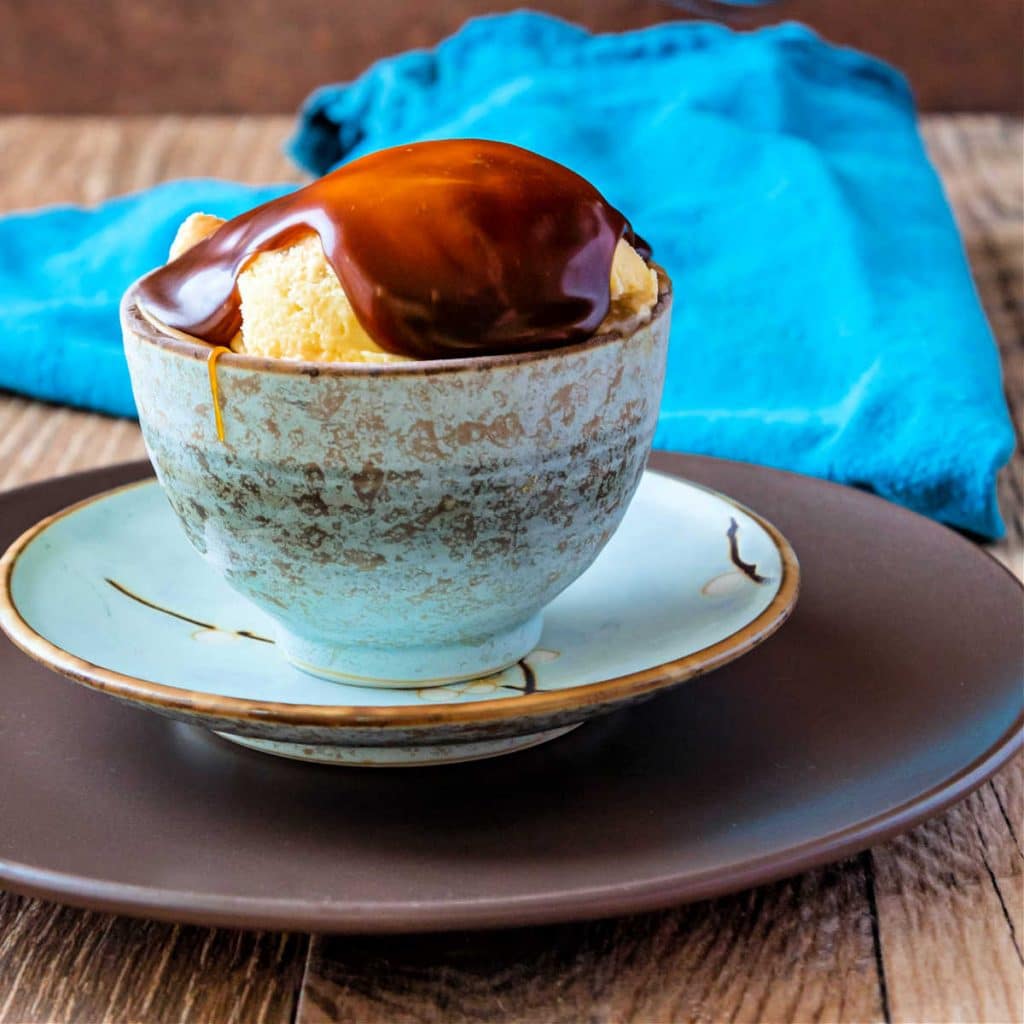
As much as I love a smooth and creamy texture, sometimes it pays to up the ante with some crunch.
For an easy butterscotch ripple sundae, scoop the ice cream, top with warmed butterscotch ice cream sauce or even this easy butterscotch coffee syrup. Add a dollop of hand-whipped cream and a sprinkling of butterscotch pecans from my pumpkin butterscotch angel food bread pudding recipe. or just use plain chopped toasted nuts.
Bonus points for building the whole thing on top of a slice of butterscotch sheet cake or a rich butterscotch blondie!
Also, consider topping butterscotch ripple ice cream with hot fudge sauce or chocolate syrup.
Make ice cream sandwiches by sandwiching a big old scoop of butterscotch ripple between two brown butter chocolate chip cookies.
Questions?
If you have any questions about this post or recipe, I am happy to help.
Simply leave a comment here and I will get back to you soon. I also invite you to ask question in my Facebook group, Fearless Kitchen Fun.
If your question is more pressing, please feel free to email me. I should be back in touch ASAP, as long as I’m not asleep.
A Note About Measurements
My recipes are almost all written by weight, including liquids, unless otherwise specified.
For accuracy and consistency of results, I encourage you to buy–and use–a kitchen scale.
I promise that baking and cleanup will be so much quicker and easier.
This is the scale that I recommend for home use. I have owned and used one for years.
Don't let its small price and small size fool you. The Escali Primo is an accurate and easy-to-use food scale that I have used for years. It's easy to store, easy to use, has a tare function, and easily switches between grams and ounces/pounds for accurate measurements.
Love This Butterscotch Ripple Ice Cream? Please Rate and Review!
It will help me and other readers so much if you take a moment to rate and leave a review for this recipe.
You can use the stars to rate 1-5 (5 is best), and leave a review in the comments. It helps me make adjustments if any are needed, and comments help others decide whether the recipe is worth making.
Other ways to share include pinning, and/or sharing on your favorite social media platform.
Thank you so much for taking the time!

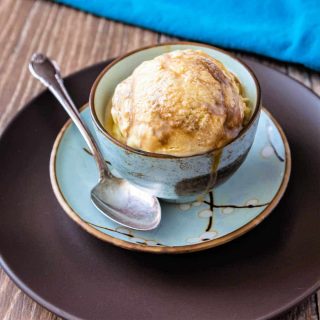
Butterscotch Ripple Ice Cream Recipe
Would you like to save this post?
Ingredients
For the Butterscotch Ripple
- 2 oz unsalted butter
- 3 oz dark brown sugar
- ⅜ teaspoon kosher salt 2 grams salt
- 2 oz water
- 3 oz heavy cream
- ¼ teaspoon vanilla extract
For the Ice Cream Base
- 2 egg yolks
- 3 oz granulated sugar
- 1 oz water
- ⅛ teaspoon kosher salt pinch
- 10 oz heavy cream
- 8 oz sweetened condensed milk
- 3 oz evaporated milk
- 3 oz whole milk
- 2 teaspoons vanilla extract or paste
Instructions
- For the Ripple
- In a medium-sized sauce pan, stir together the butter, dark brown sugar, and salt with the water.
- Put the lid on and heat over medium heat until the butter melts.
- Remove the lid and cook over medium-high heat until the butter browns and the sugar caramelizes. You'll know it's done when the mixture begins to smell like caramelized sugar.
- Add the heavy cream all at once. Be careful, the mixture will bubble up.
- Stir off the heat until the butterscotch is smooth. A whisk works better than a spoon for this.
- Cook over medium heat until the mixture reaches 240F.
- Pour into a heat-safe container and stir in the vanilla. Let cool to room temperature.
- For the Vanilla Base
- Using a hand mixer, whip the yolks and salt together until very light and creamy. Set aside.
- Combine the sugar and water in a small saucepan.
- Bring to a boil and cook until the sugar reaches 240F.
- With your hand mixer on, stream the hot sugar syrup into the yolks, whipping until very pale, thick, and billowy. This is your pate a bombe.
- In the bowl of your stand mixer fitted with the whisk attachment, whip together the heavy cream, sweetened condensed milk, and vanilla until thickened. The whisk will leave tracks in the base.
- Scrape in all the pate a bombe and continue to whip until you get very soft peaks.
- Add the whole milk and evaporated milk and whisk until well-combined. Mixture will thin out some.
- To Layer the Two
- You have two options. First, you can layer in about 1/3 of the base and let it freeze for about 45 minutes before adding 1/3 of the butterscotch.
- Repeat with more base, sauce, base, and finish with the sauce, allowing 45 minutes to an hour of freezing between layers.
To speed things along a little bit, here's option 2:
- Place the metal mixer bowl filled with ice cream base into the freezer. Whisk it every 45 minutes to incorporate the outer frozen parts with the rest of the base. After 3-4 rounds of this, you'll have an ice cream base that is about the texture of soft-serve ice cream.
- Then you can layer the base and butterscotch all at once: 1/3 base, 1/3 butterscotch drizzled all over the base, etc, until you fill the pan.
- In either case, press plastic wrap onto the surface of the ice cream and freeze at least 8 hours before serving.
- You may need to let the ice cream sit out for 5 minutes or so before scooping.
- For best flavor and texture, enjoy within about 10 days.
Did You Make Any Changes?
Notes
Nutrition

Hi, y’all! I hope you’ve enjoyed this post and hopefully also learned a thing or two.
If you like my style, I invite you to sign up for my occasional newsletter, The Inbox Pastry Chef.
Expect updates on new and tasty recipes as well as a bit of behind-the-scenes action. I hope to see you there!
And there you have it: delicious, rich, butterscotch ripple ice cream.
I hope you love it!
Take care, y’all.

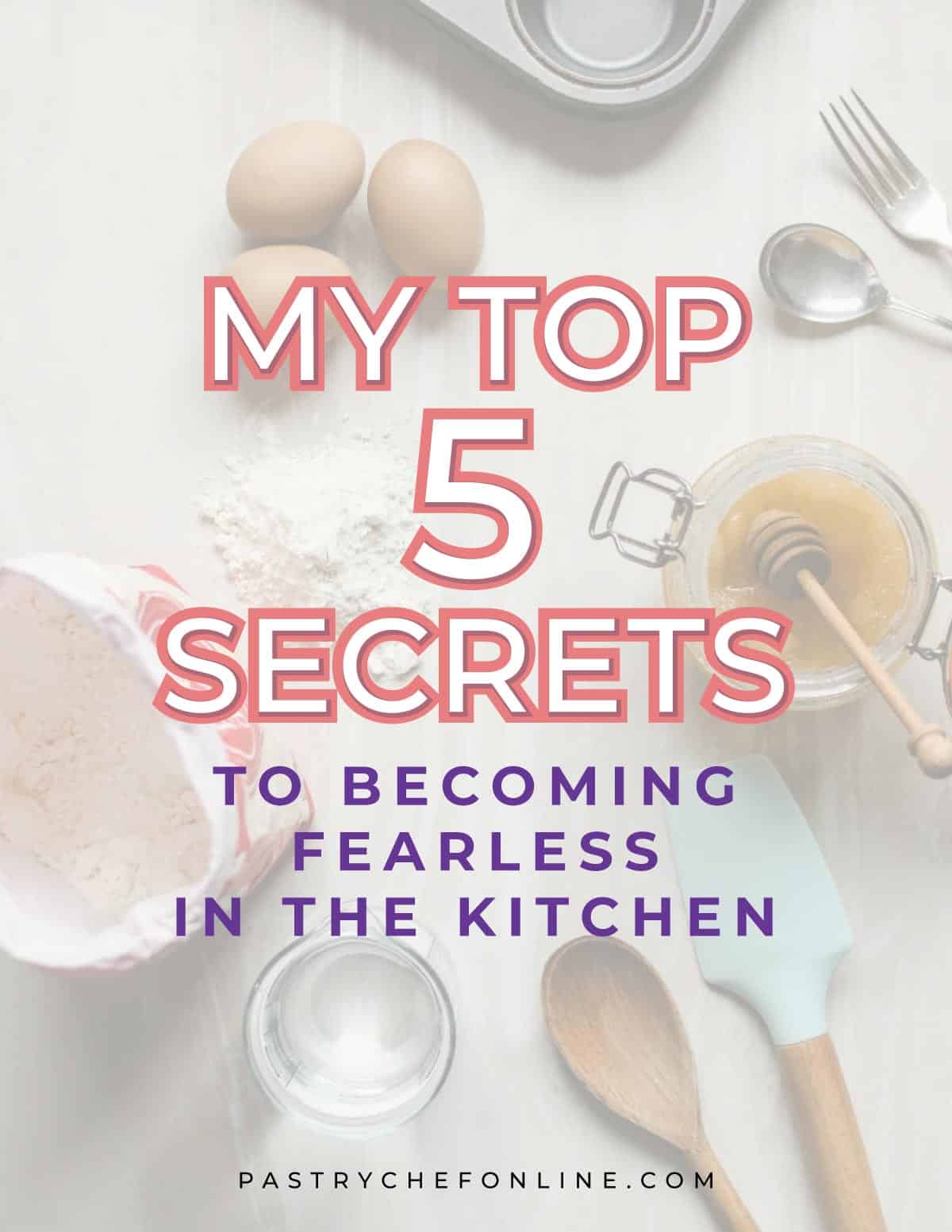
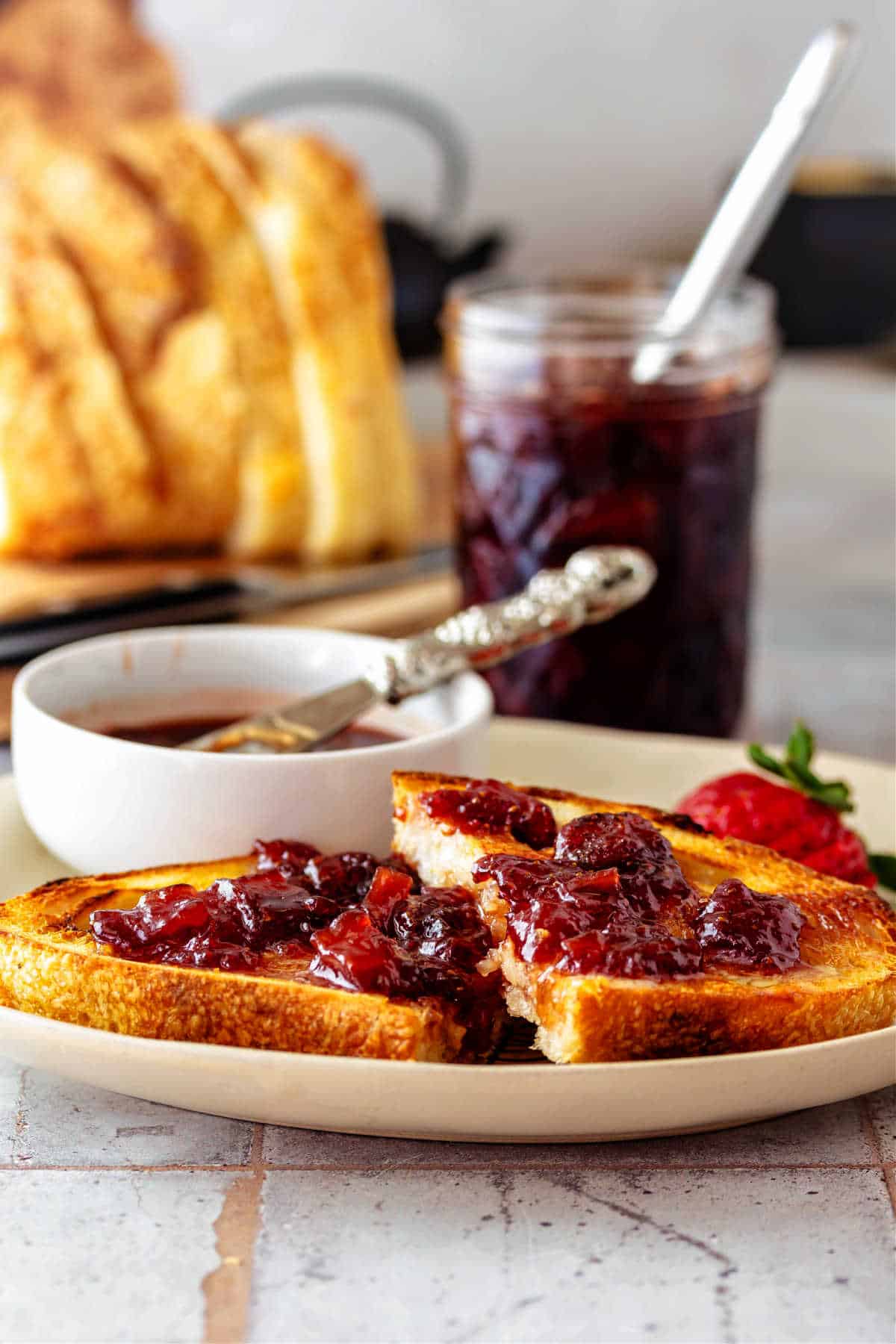
Join in Today!
